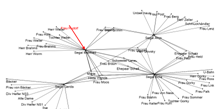
CFP workshop historical network analysis
Since a few years a group of German scholars regularly convenes to discuss the potential and issues surrounding the use of network methods for the historical discipline. Marten Düring is one of the prominent people in this group, and he presented his work at The Connected Past symposium here in Southampton in March 2012 (you can see a video of his presentation on the TCP website).
Continue reading →



